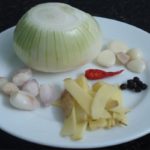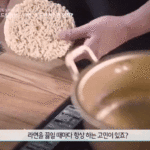Pork intestine is a favorite dish of many Vietnamese people. Instead of buying it from outside, many families will prepare it themselves at home to ensure food safety and hygiene. However, cleaning pork intestine is not always easy. If you don’t know how, it can have a foul smell and won’t become crispy when boiled.
According to chefs, to clean pork intestine, you can use ingredients that are available in your kitchen. Here are some tips on how to clean pork intestine.
How to choose fresh pork intestine
If you’re buying fresh pork intestine, choose ones that have a pink color and feel thick when touched.
Choose sections of intestines that have small, round tubes and are not discolored.
Squeeze the intestine with your hand to check if the inside looks white. If it’s white, it means the intestine is fresh. If it’s yellow, it may taste bitter and should not be purchased.
Avoid buying intestines that are sticky, have a strong fishy odor, as they may be from a sick or old pig.
How to clean pork intestine
When you bring the intestine home, rinse it with water several times to remove any dirt inside.
Place the intestine in a bowl and add a tablespoon of salt. Squeeze it to remove any dirt.
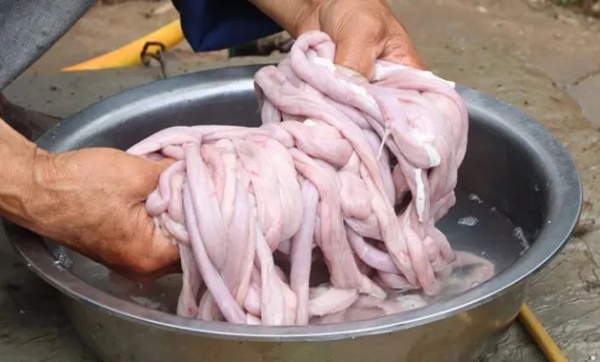
Next, use a knife or scissors to trim off excess fat around the intestine. Don’t remove all the fat, leave a little fat near the intestine. This will prevent the intestine from becoming dry and help retain its rich flavor.
In a bowl, add a tablespoon of flour (or sweet potato flour). Use your hands to rub the flour onto the surface of the intestine. Do this for about 3 minutes, then rinse the intestine with clean water.
Add half a can of Coca-Cola to the bowl of intestine and continue to use your hands to remove any mucus and dirt.
After about 3 minutes, rinse the intestine again with water until clean.
Next, take a chopstick and insert it into the non-hollow part of the intestine. Flip it inside out, then rinse it with water twice. Add flour and knead it thoroughly to ensure cleanliness. Then, use Coca-Cola to clean it similarly as before.
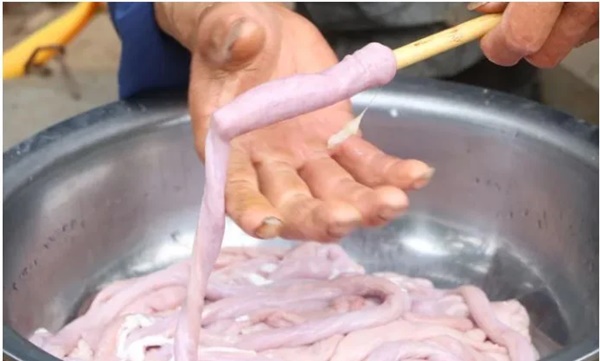
Once both the inside and outside of the intestine are clean, use a chopstick to flip it back to its original position. Rinse it one more time with water and let it drain.
Now you have a clean pork intestine, ready to be used in your favorite dishes.
Boiling the intestine
Add water to a pot and add a few dried shallots (or ginger, lemongrass), a tablespoon of salt, and half a tablespoon of seasoning powder.
While waiting for the water to boil, prepare two bowls of cold water. One bowl with only ice water, and the other bowl with ice water and lime juice.
When the water is boiling, add the clean pork intestine into the pot. Boil it quickly for 30 seconds, then remove it and soak it in the bowl of ice water prepared earlier.

When the intestine has cooled down, put it back into the boiling water. Boil it again for another 30 seconds, then remove it and soak it in the bowl of ice water to cool down. Repeat this step 4 times to fully cook the pork intestine.
On the fourth time, remove the intestine from the pot and soak it in the bowl of lime water. Let it soak for about 10 minutes until the intestine is completely cooled. The water should cover the intestine, so it won’t become discolored.
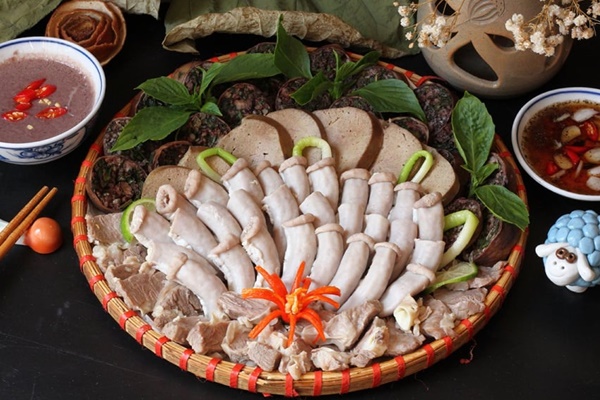
When the intestine has cooled down, remove it and let it drain. Cut it into bite-sized pieces.
Source: Xe và Thể Thao
More Useful Advice for Homemakers (Part 2)
Have you heard of the surprisingly easy tips to make cooking and household chores simpler? White radish eliminates the acrid taste of salted meat, adding alum to raw shrimp helps soften it, and adding cold water when frying eggs can make them crispy – these are just a few of the tricks to make your life easier.
Ten Strategies to Streamline Your Cooking Process
Are you a busy housewife looking for ways to save time in the kitchen? Did you know that flossing can also help you out? Check out these 10 tips to help you quickly and easily prepare delicious meals for your family. Learn how to peel garlic in 10 seconds and cut cherry tomatoes quickly for a healthy and tasty meal.


























